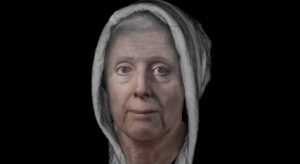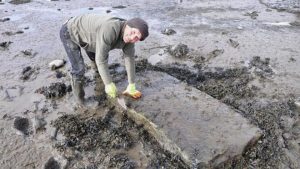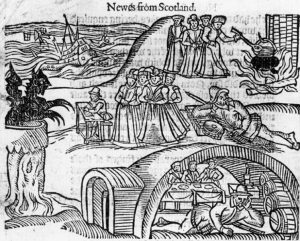Lilias Adie – A victim of Scotland’s witch hunt
After reading an article in the Scottish Banner (December 2019) I was motivated to find out more about Lilias Adie and share her story and this aspect of Scottish history with members of the Clan. Admin.

A digital reconstruction of Lilias Adie’s face (University of Dundee)
In the early 1700s, a Scottish woman named Lilias Adie was accused of witchcraft and sentenced to burn at the stake. But before the brutal execution could be carried out, she died in prison, possibly of a suicide. Adie’s body was hastily buried along the shores of the country of Fife, in an ignominious spot. To ensure that the devil did not reanimate his purported collaborator, the grave was covered with a hulking, half-ton slab.
In the following centuries, morbid curio hunters were nevertheless able to access the humble wooden box that served as Adie’s coffin and pilfer her bones. Now, as Nan Spowart reports for the National, officials have put out an appeal for the return of Adie’s remains, in the hopes of finally giving her a respectful memorial.
Starting in the mid-1400s, Europe was gripped by an anti-witch hysteria, leading to the executions of some 80,000 people between 1500 and 1660. Most victims were women, a phenomenon that historian Steven Katz has attributed to “the enduring grotesque fears [women] generate in respect of their putative abilities to control men and thereby coerce, for their own ends, male-dominated Christian society.”
Adie’s story, which is preserved in the minutes from her 1704 trial, reveals the frenzied, tragic pattern of false accusations and false confessions that defined many other witchcraft cases. A woman named Jean Bizet, who “seemed drunk,” according to witnesses, began making accusations against Adie, warning neighbours to “beware lest Lilias Adie come upon you and your child.” Bizet continued to appear “strangely distempered” the next day, crying out, “by God he is going to take me! by Christ he is going to take me! O Lilly with her blew doublet!”
According to Meagan Flynn of the Washington Post, Adie subsequently spent more than a month in prison, where she was interrogated and possibly tortured. Ultimately, she confessed, proffering a wild tale about meeting with the devil “in the harvest, before sunset” and renouncing her baptism. During this “tryst,” she claimed, “the devil lay with her carnally … [H]is skin was cold, and his color black and pale, he had a hat on his head, and his feet was cloven …”
It was widely believed at the time that Satan would resurrect his followers from the dead so they could stalk the pious living. Burning suspected witches at the stake was thought to solve that problem, but in Adie’s case, officials had to find something else to do with her remains—hence the unceremonious grave, topped with a hulking stone. Because most other accused witches were burned, the site of Adie’s burial, identified in 2014, is the only known “witch” grave in Scotland,
Her remains were dug up by antique-collecting grave robbers in 1852. At the time, it was reported that the coffin was 6 feet 6 inches (about 1.98 m) long. Her thighbones were found to be of comparable length with those of a man who was 6 feet (about 1.8 m) tall. She still had most of her teeth, which were “white and fresh”.

Adie’s grave slab uncovered in 2014
Adie’s coffin was also a source of souvenirs: a walking stick, believed to be made from the wood of her coffin and with a silver band near the handle engraved with “Lilias Addie, 1704”. The skull was in the private museum of Dunfermline antiquarian Sir Joseph Noel Paton in 1875. It was exhibited to the Fifeshire Medical Association in 1884 by a medical doctor from Dunfermline named Dow. It was eventually held at the Museum of the University of St Andrews, but has since disappeared. The skull was exhibited in 1938 at the Empire Exhibition at Bellahouston Park in Glasgow, its last known location. Fortunately, pictures were taken of the cranium before it vanished, which, in 2017, allowed experts to produce a reconstruction of Adie’s face.
Fife Council has put out an appeal for the return of Adie’s remains, in the hopes of finally giving her a respectful memorial.
“There was nothing in Lilias’ story that suggested to me that nowadays she would be considered as anything other than a victim of horrible circumstances,” forensic artist Christopher Rynn told the BBC at the time. “So I saw no reason to pull the face into an unpleasant or mean expression and she ended up having quite a kind face, quite naturally.”
On 31 August 2019, 315 years after Adie died in custody, a memorial service was held in Torryburn and a wreath laid at the site of her grave to raise awareness of the persecution these women and men endured in Fife during the witchcraft panics.
The new campaign may be centred on finding Adie’s lost bones, but Fife officials also hope to use it to raise a broader awareness of the terrible injustices perpetrated against some 3,800 men and women who were accused of witchcraft in Scotland between 1563 and 1736, when the country’s Witchcraft Act was enforced.

An illustration of Scotland’s North Berwick witches, which are shown meeting Satan in the local churchyard. Witchcraft paranoia led to thousands of executions across a 200-year period. From the contemporary pamphlet ‘Newes From Scotland.’ 1590.
Ref:
- Brigit Katz (smithsonianmag.com – September 3, 2019 ) https://www.smithsonianmag.com/smart-news/wanted-missing-bones-scottish-witch-180973033/
- https://en.wikipedia.org/wiki/Lilias_Adie
- https://allthatsinteresting.com/lilias-adie
